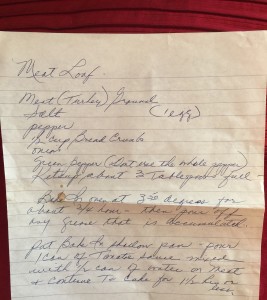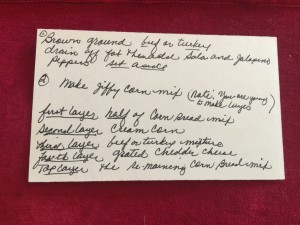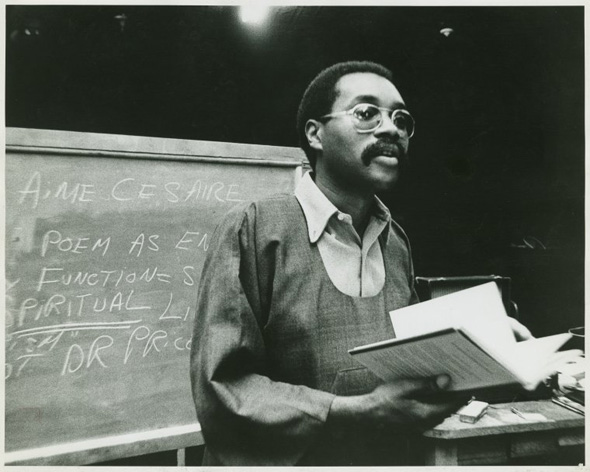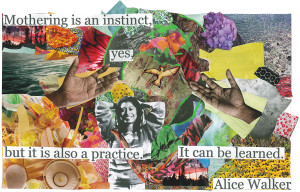
Collage for Claudia Jones by Alexis Gumbs
Folks, I had all but forgotten to tell you that, on behalf of the class, I subscribed to the Black Feminist Breathing Chorus, an initiative by Alexis Pauline Gumbs BC ’08. I invite you to use these meditations as we go through the rest of the year. (I will give out the password in class). I think they are a perfect compliment to the kind of work many of you are doing.
If you went to the “Who’s going to sing a black girl’s song” event a few weeks ago, you know that Alexis is a writer, artist and intellectual whose work on black feminist intellectual history and theorizing on gender, race, sexuality and love has been provoking and elevating those of us who follow her work. In 2014, Alexis extended her summer freedom school, “The Eternal Summer of the Black Feminist Mind,” online with the Black Feminist Breathing Chorus. One thousand people followed her for 21 days as she created breathing meditations and collage art based sources of inspiration close to her. One of the things I love about her meditations is that she reminds us in how many ways the black women we’ve been reading about all semester were thinking of the world in terms we are only gaining words for now. For example, when she notes that, along with her other work, Fannie Lou Hamer was a food justice activist.
From an early email from Alexis:
This winter people around the United States have been protesting police violence by repeating the tragic last words of Eric Garner: “I can’t breathe.” Here in Durham activists have been diligently drawing attention to acts of police violence and harassment in our own community. As an act of love for a community in transformation, local artists Alexis Pauline Gumbs and Julia Roxanne Wallace are using a technology they call “Black Feminist Breathing” to offer one strategy for how outraged, and exhausted communities can connect to a legacy of activism and build resources for their long-term spiritual, emotional and physical resilience.
Gumbs, who has a PhD in English, African & African American Studies and Women & Gender Studies from Duke University, began “Black Feminist Breathing” as a personal resilience practice. Instead of chanting mantras from other cultures, in languages she did not know, she decided to meditate by repeating affirmations and quotations from black historical figures, from Audre Lorde and Pauli Murray, to Bayard Rustin and Harriet Tubman, who have inspired her lifelong commitment toblack feminism.
After chanting these affirmations alone in her office for a year, and sharing them at the community events that her non-traditional school, Eternal Summer of the BlackFeminist Mind, hosts around the United States, in Summer 2014 Alexis decided to share this practice online through a daily “Black Feminist Breathing Chorus” which had nearly 1000 daily participants for 21 days. For this meditation series Gumbs’s primary collaborator and life-partner Sangodare (also known as Julia Roxanne Wallace) composed original music to accompany each affirmation. Gumbs also created intricate visual remixes of iconic images of the historical figures that the meditations honored.








 For the past few weeks, I have been thinking about the concept of being a daughter and how that is a motif in Shange’s work. My understanding of the saliency of (what I call) “daughtership” was further developed through my reading of Sassafrass, Cyprus and Indigo and during the Africana Department event “Who’s Going to Sing A Black Girl’s Song?” A Conversation on Black Girlhood with distinguished Africana alumnae Asali Solomon ‘95 and Alexis Pauline Gumbs ‘04.
For the past few weeks, I have been thinking about the concept of being a daughter and how that is a motif in Shange’s work. My understanding of the saliency of (what I call) “daughtership” was further developed through my reading of Sassafrass, Cyprus and Indigo and during the Africana Department event “Who’s Going to Sing A Black Girl’s Song?” A Conversation on Black Girlhood with distinguished Africana alumnae Asali Solomon ‘95 and Alexis Pauline Gumbs ‘04.
